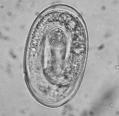Difference between revisions of "Dictyocaulus arnfieldi"
Jump to navigation
Jump to search
| Line 66: | Line 66: | ||
*Treat donkeys with appropriate anthelmintic in spring if grazed with horses. | *Treat donkeys with appropriate anthelmintic in spring if grazed with horses. | ||
[[Category:Trichostrongyloidea]][[Category:Horse_Nematodes]] | [[Category:Trichostrongyloidea]][[Category:Horse_Nematodes]] | ||
| + | [[Category:To_Do_-_Parasites]] | ||
Revision as of 22:00, 25 June 2010
Lungworm
DICTYOCAULUS ARNFIELDI
General
- Lungworm of equidae; adult worms found in smaller bronchi. Frequently incriminated as the cause of a chronic cough.
Morphology and Life-Cycle
- Similar to lungworm in cattle, except:
- embryonated eggs (80-100µm) passed in fresh faeces; and
- prepatent period = 12weeks.
Epidemiology
- Main source of infection = donkeys (remain infected for years) - contaminate horse pasture.
- Infection can cycle in horses.
| Horses | Donkeys | |
|---|---|---|
| Prevalence | 10-20% | 75% |
| Adult worms | Few | Many |
| Eggs in faeces | Often zero | Many |
| Period of patency | <8months | 5+ years |
| Clinical signs | Sometimes | Rarely |
NOTE: Clinical signs - chronic cough at rest or during exercise, single animal or group of horses, autumn or early winter.
- Dictyocaulus arnfieldi causes cough in horses
Pathogenicity
- Raised areas of over-inflated pulmonary tissue (several cms in diameter) surrounding small bronchus containing worms and mucopurulent exudate.
- Hyperplastic bronchial epithelium.
- Peribronchial "cuffing".
Diagnosis
- Clinical signs.
- Grazing history (donkey contact or shared grazing).
- Faecal examination (only detects patent infections = small proportion of lungworm infections in horses):
- process sample immediately = McMaster method, embryonated eggs
- process sample later = Baerman technique, larvae with tail spine.
- Tracheobronchial washings (large eosinophils).
- Response to anthelmintic treatment (e.g. resolution of clinical signs = retrospective diagnosis).
Control
- Do not keep horses on pastures grazed by donkeys (potential carriers).
- Treat donkeys with appropriate anthelmintic in spring if grazed with horses.
